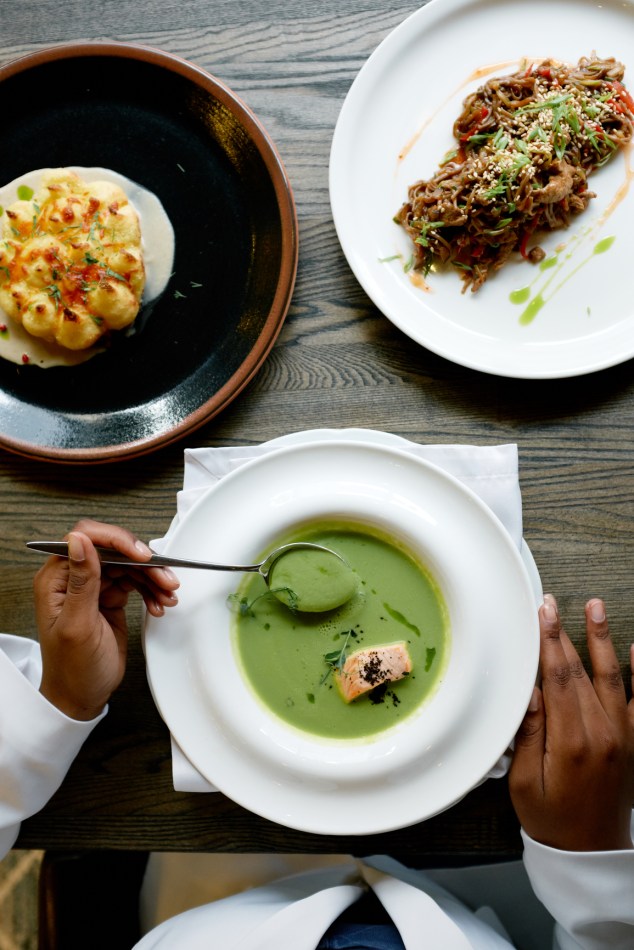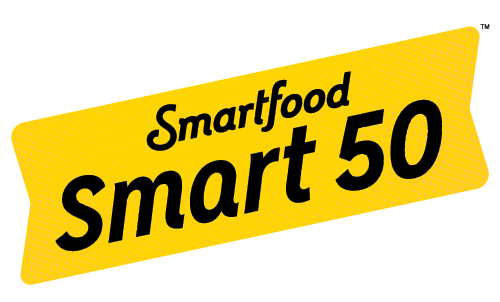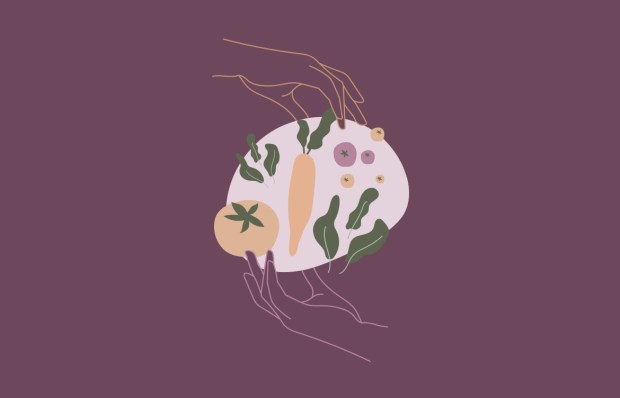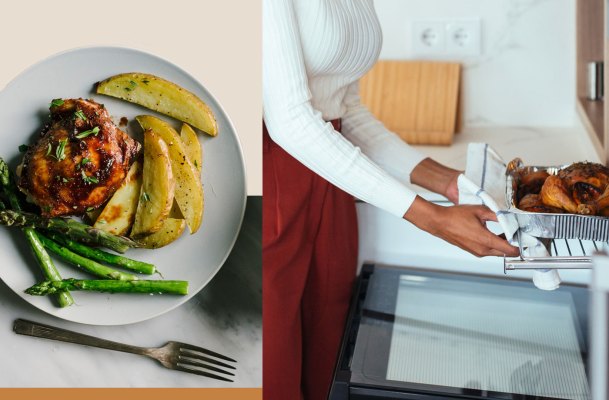The Big Picture
There are few places more representative of the change wrought by COVID-19 than the kitchen. A report from PwC found that 51 percent of Americans reported a “significant increase” in home cooking thanks to the pandemic. According to Maya Feller, RD, food has served as a form of comfort as COVID-19 cases rise and economic prospects remain uncertain at best. (Just look at the soaring popularity of homemade sourdough, banana bread, and even nostalgic packaged snacks since March.) And after a year of so much turmoil, our food choices in 2021 will be all about alignment—nutrition that aligns with our individual health needs, and food choices that align with values like sustainability and racial and economic equity.
In this new context, more people will realize that the restrictive dieting so commonplace in wellness no longer serves their physical or emotional well-being. Dietitian-influencers like Christy Harrison, RD, Shana Minei Spence, RDN, and Dalina Soto, RD, have long educated their hundred of thousands of followers that restriction leads to bingeing, psychologically damaging guilt and shame, and an increased risk of disordered eating—and 2020 yielded the fruits of that labor in the form of backlash to high-profile diet programs like F-Factor and All In By Teddi. In fact, data from the International Food Information Council Federation finds that 39 percent of Americans are newly interested in mindful or intuitive eating, practices that emphasize listening to your body and its needs when determining what and how to eat. “Mindfulness has been bubbling up for the past year or two,” says Brigitte Zeitlin, MPH, RD, “but I think COVID-19 has escalated the conversation.”
With that in mind, more people will seek out personalized nutrition solutions that work for their unique circumstances—like eating specifically for heart health or diabetes prevention. “People are concerned about those non-communicable diseases in relation to the pandemic and their overall longevity,” Feller says. New-to-2020 companies like Sugarbreak and Muniq (which make supplements and shakes for people with diabetes) as well as apps like Zoe and Wellory (which create eating plans for people based on biometric data and digital dietitian consults, respectively) will support people on their quests for tailor-made nutrition. Books like Mastering Mindful Eating, by Michelle Babb, RD (out in December), and Intuitive Eating for Every Day, by Evelyn Tribole, co-founder of the intuitive eating movement (out in March 2021), will also help people learn to better tune in to the needs of their own bodies. Zeitlin says 50 percent of her clients have questions about mindful eating: “Once they ‘get it,’ there is a big shift in their relationship with food,” she adds.
The forthcoming 2020-2025 U.S. Dietary Guidelines (due to be released in January) will also support this move towards eating what feels right for you: Feller says they will include messaging from governmental health agencies on how to personalize the broad recommendations to your individual needs and background. (Other changes to expect: new guidance on added sugar intake and the first guidelines for pregnant and breastfeeding people.)
Another major factor transforming people’s relationship with food is the climate crisis. More than ever, “environmental concerns are weighing bigger on peoples’ minds as we’re seeing that every year we are getting closer to a tipping point where if we continue on the path we are on…this world could become more difficult to live in for all species—including our own,” says Dana Hunnes, PhD, RD, adjunct assistant professor at the University of California Los Angeles Fielding School of Public Health. The issue is especially important to Black, Indigenous, and people of color (BIPOC), Feller adds, as these groups are disproportionately affected by climate change’s effects. “My hope is that people will look more towards plant-based food choices, which are significantly better for the environment than animal foods,” Dr. Hunnes says—a safe bet given that sales of plant-based products, like oat milk and alt-meat, have soared during the pandemic. But don’t count out meat entirely; with sales of sustainably-sourced meat also skyrocketing this year and the grass-fed beef industry expected to grow by $14.5 billion between now and 2024, better-for-the-planet animal products will have a place on many of our plates, too.
“People are going to be thinking about, ‘How do I make sure that I have good food that’s affordable and healthy?’” Maya Feller, RD
In addition to the climate crisis, the ongoing economic crisis—and the historic increase in food insecurity—will transform the way many Americans think about food and community, specifically pushing many to newly consider food equity as a cornerstone value. “People are going to be thinking about, ‘How do I make sure that I have good food that’s affordable and healthy?’” Feller says. Indeed, Nielsen polling shows that 23 percent of Americans plan to grow their own food if the economy worsens, and 19 percent of Americans plan to use food banks more. As new federal aid continues to stall, expect to see a continued increase in local solutions for food access, such as community fridges and gardens. (Case study: New York City’s first “Freedge”—a grassroots community fridge program—opened in February; now there are over 60 across the five boroughs.)
The ongoing reckoning with racism in the food industry—propelled by the protests over the death of George Floyd—will slowly start to expand who is part of the larger American food culture, says Jenny Dorsey, chef and founder of Studio ATAO, a food and community-focused nonprofit. “The ingrained food culture in the U.S. is not the only food culture that exists,” she says, and the U.S. has a lot to learn from Indigenous, Ayurvedic, and traditional Chinese medicine-based food practices, for instance. While legacy food publications—including Bon Appetit and the New York Times Food and Cooking sections—start to hire more BIPOC folks and overhaul their style guides to decenter whiteness, groups like For the Culture (a forthcoming biannual magazine founded by Klancy Miller that celebrates Black women in food) will provide new coverage and visibility for BIPOC chefs and creatives, allowing them to shape what foods and ingredients hit the “mainstream.” There is a long way yet to go to make all areas of the food industry more equitable (not a single major food retailer has adopted the 15 Percent Pledge, for example) but for the first time in a long time, there are positive steps being taken towards a better future—so long as we’re willing to keep up the momentum.
For many folks, the novelty of the quarantine kitchen has officially worn off: A September 2020 report by marketing firm Acosta found that 25 percent of people have grown tired of cooking. And to lessen mealtime stress, 53 percent of American adults are now turning to heat-and-eat meals. Weary home chefs will be happy to hear that the new class of healthy, quick-to-make options are a far cry from the microwavable bowls and TV dinners stashed in the freezer.
“Half-scratch cooking” meal kits—which come with pre-prepped ingredients so all that’s left for you to do is cook and consume—are leading the charge. “Sales for meal kits have grown tremendously this year,” says Laurentia Romaniuk, a trends expert at Instacart, speaking to the growing interest.
New pre-prepped options are already available, including Down To Cook (boxed meal kits that only require adding your veggie of choice), which launched in May 2020. Fast-casual chain Just Salad also launched its first-ever deliverable zero-prep meal kits in April as part of its New York City-focused grocery service, Just Grocery. And more products will be on the way in 2021, such as expanded offerings from Hungryroot, which sells pre-prepped ingredients meant to be mixed and matched together, and Kevin’s Natural Foods, a Paleo-inspired line of five-minute cooking kits. “The focus in 2021 is expanding the menu,” says Kevin’s Natural Foods co-founder Kevin McCray—such as launching a steak-based entrée early next year. You can also expect Down to Cook products (including soon-to-launch breakfast options) to arrive in retail markets starting in 2021, says Trishna Saigal, the brand’s founder and CEO.
Even established meal kit companies are taking note and adding more time-saving options to their lineups. Sun Basket launched its own heat-and-eat meals that are ready in six minutes flat—even quicker than its standard recipe cook time of 25 minutes. Vanessa Meyers, Sun Basket’s senior vice president of growth, says more than 50 percent of the brand’s customers have added the new quicker options to their orders since the launch in August. Home Chef, a subsidiary of Kroger, also announced in November that its meal kits line will be expanded to include dinners that can be prepped in five minutes (as opposed to its current offerings, which typically require 45 minutes of prep).
With meal kits this quick to assemble, you’ll be able to give your Grubhub app a break, too.
Kevin McCray
Founder of Kevin’s Natural Foods
“People have become masters at semi-homemade cooking. It makes sense. For years, culinary shortcuts like parboiled rice, pre-cooked pasta sauce, and blanched or frozen vegetables have been helping families get dinner on the table. At Kevin’s, we [ask]: How much of the culinary legwork can we tackle for our customers without decreasing the flavor or nutritional value of the meal?”
Photo: Hungry Root
While the soft drinks industry has declined by an average of 4 percent per year over the past five years, sparkling water is popping off. In fact, it’s expected to grow at an annual growth rate of 12 percent from 2020 to 2027. According to George Daines, category merchant of beverage at Whole Foods Market, this growth is motivation for brands to keep things fresh, and in the new year, we’ll be treated to a slate of seltzers that pack an extra dash of health benefits—think, vitamins, adaptogens, and probiotics—into each can.
These boosted sparkling waters are the next step in the steadily growing functional foods movement (a category that’s expected to increase in value at a rate of 7.5 percent per year from 2020 to 2027). “Each drink is specifically formulated to help with things like increased energy, immunity, focus, and occasional stress,” Britt Dougherty, co-founder of Heywell, says of the brand’s line of functional sparkling waters, which began rolling out at select Target stores in October and will be expanding into more locations this spring. Heywell’s products feature ingredients like ashwagandha, schisandra, and L-theanine.
Boosted seltzers started percolating a few years ago with the arrival of turmeric sparkling water brand ARYA (launched in 2017), electrolyte-infused Käter Wingman (launched in 2018), and CBD sparkling water brands Recess and DRAM (launched in 2018 and 2019, respectively), but new releases on the horizon make it clear that functional sparkling water will reach mainstream status in 2021. Take new cans from Sipp and Rockaway (superfood- and adaptogen-boosted sparkling waters, respectively), which appeared on store shelves in the back half of 2020. Droplet launched its line of adaptogen- and superfood-infused sparkling waters in September and will expand beyond independent retailers into traditional grocery stores in early 2021. And look out for 2021 launches from probiotic-infused water brands Huzzah, Wildwonder, and Bio-K+ (the latter entering regional chains at the start of the new year), as well as from a new CBD water brand called Fountain.
Consumers are drinking up this trend, but what do the health experts think? Spoiler: They’re fans, too. “These are exciting new ways to hydrate," says Lori Rowell Welstead, RD, a registered dietitian at The University of Chicago Medicine. While sparkling water and seltzers are already healthy alternatives to sodas and other sugary drinks, Welstead says having these functional ingredients—in moderation—may provide additional health benefits. For example, “probiotics are a key component of maintaining gut health integrity and serve to keep the good bacteria in the gut populated,” says Alana Kessler, RDN.
“The sparkling water boom shows that hydration is a staple item that can bring people a lot of joy, while also helping them reach their own personal health goals,” says Celeste Perez, co-founder and CEO of Droplet. With functional sparkling water becoming more readily available in 2021, you’ll have a lot more to choose from with your bubbles than just peach-pear or pamplemousse.
Photo: Heywell
The pandemic taught Americans to get scrappy in the kitchen. Looking to save money (and trips to the grocery store), they found creative ways to use more of the ingredients they had purchased. You could say they took their overripe bananas and made banana bread. And in 2021, you’ll see brands join this upcycled food movement with a slate of new products that repurpose bits of food that would otherwise go to waste into new items.
Upcycled foods are also reflective of another quality valued by shoppers: sustainability. “Consumers are growing increasingly aware of sustainability and their own purchasing power. They’re looking for new ways to engage in sustainable practices, and are willing to try new things to do so,” says Kelly Landrieu, global coordinator of local brands at Whole Foods Market, which also predicts upcycled foods will gain prevalence in 2021. It’s on Kroger’s radar, too. In September 2017, the brand launched a Zero Waste Foundation, which funds companies committed to ending food waste, and in the spring of 2020, they awarded funding to upcycled food brand Ripe Revival for the second year in a row.
A few brands you’ll spot on store shelves: Barnana, which turns bananas deemed too “imperfect” for the produce section into snack foods (100 million upcycled bananas and counting), was an early innovator in the space, launching in 2012 and reporting steady growth since then. Outcast released its line of protein powders made from surplus fruits and vegetables in 2018, and this year moved into a production space 15 times the size of its previous one in order to keep up with demand. The rapid success of two new brands that launched during the pandemic, Agua Bonita (aguas frescas made from “ugly” produce) and Goodfish (salmon chips made from used salmon skin), are further proof that consumers are using their dollars to show support for sustainable initiatives. “We've already gone from prototype to nearly selling out our first production run,” says Agua Bonita co-founder and CMO Erin PonTell, who says that the direct-to-consumer brand will also be available on store shelves in 2021.
Goodfish founder Justin Guilbert says he’s excited not only about the growth he’s seen for his business, but more so the good it's doing for the planet: “Since launching in March, we’ve purchased and given purpose to over 164,000 pounds of salmon skins that would have gone to waste, increasing the value of each fish, and helping to support 15,000 jobs,” he says.
Considering that the United Nations estimates that $400 billion of food is wasted before it even gets delivered to stores, this is one shift in the food world that’s more than just a trend: It’s a movement toward a more sustainable way to eat.
Adaptogenic mushrooms—varieties like reishi and lion’s mane that benefit cognitive health, stress levels, and immune support—have been mainstays in wellness circles for years. But the pandemic has shown the mainstream American market what East Asian medicinal traditions have understood for decades: the potential of mushrooms for supporting health.
The extreme challenges of the pandemic created an increased interest in minimizing stress and anxiety through food, says Tero Isokauppila, the founder of functional mushroom brand Four Sigmatic. Same with cognitive support, he adds—in the era of Zoom fatigue and anxiety-induced brain fog, consumers are looking for any kind of advantage.
Taste was long a barrier to mainstream acceptance of functional mushrooms, says Isokauppila, but product innovation has made these potent fungi easier to swallow. You can now find them incorporated into premade lattes from 2020 newcomers Earth & Star and Taika, a new line of salad dressings from Tessemae’s (which dropped in October), and even chewing gum from Mighty Gum. Plant-based protein powders loaded with mushrooms will be the latest format to try, thanks to 2020 launches from Four Sigmatic. Functional mushroom brand Spore, which launched in 2020, plans to expand beyond supplements to new formats in 2021.
Even culinary mushrooms like shiitake—which is also loaded with vitamins and immune-supporting nutrients—will become more popular in 2021, says Shizu Okusa, founder and CEO of adaptogen brand Apothékary, as people look for more readily accessible ways to reap the health benefits of these fungi. Not only did mushroom sales increase during the pandemic, 63 percent of consumers plan to continue to cook with them “after things get back to normal,” according to a survey conducted by the Mushroom Council.
With global functional mushroom sales expected to grow 8 percent by 2024, keep your eyes open for new-to-you mushrooms like agarikon (nicknamed “the elixir of long life”) to start appearing in products, says Michael Zavet, co-founder of Spore. The potential of functional mushrooms for gut health is also an “emerging frontier” of research and product focus, adds Isokauppila. And considering Japanese market launches, “ready-to-drink shots are the future of what this trend could look like,” predicts Okusa. Time to make some room for ‘shrooms on your shelf.
Photo: Stocksy / Jill Chen
Forty-two percent of Americans say they’ll continue to load their pantries until COVID-19 is “fully resolved”—and thanks to new brand innovations, the products on our shelves in 2021 will be better than ever.
While superfoods have long hogged the spotlight in healthy eating circles, pantry staples that previously acted as supporting players just might steal the show thanks to new flavor and health upgrades. Take vinegar, which is getting the gourmet flavor treatment from brands like Acid League (which launched in August), Pineapple Collaborative (which started selling olive oil and apple cider vinegar in November 2019), Brightland (which dropped two vinegars in June), and Ramp Up (which launched in 2019 and re-packaged its vinegars in June). Or tuna, which is leaning into sustainability with new-to-2020 products like Wild Catch from Chicken of the Sea (which features wild-caught tuna and zero preservatives) and Bumblebee Tuna Pouches (portable, seasoned, wild-caught tuna). Even canned soups are adapting—this fall, Gardein dropped the first canned soup with plant-based meat, while Swanson added new flavors featuring Moroccan and Chinese spices to its Sipping Bone Broth line.
The pantry has also created an opportunity for brands to bring restaurant flavors directly to home chefs, says Marguerite Mariscal, the CEO of Momofuku. The brand launched its first line of pantry goods in September, featuring its famed Chili Crunch seasoning and a trio of seasoned salts. (You can join the wait list for Momofuku’s gourmet soy sauce and tamari, which launched in December and already sold out.) Similarly, Omsom, which sells shelf-stable sauce and spice kits for core Southeast and East Asian dishes like bulgogi and larb, launched this year with the help of nearly a dozen NYC-based chefs. (It just dropped three new kits in late October.) And spice retailer Spiceology pivoted to focus on home chefs after the pandemic ate its restaurant and catering business. With $4.7 million in new funding secured in September, it’s safe to assume the brand will continue to expand its offerings—starting with a new six-product collaboration with Huy Fung Sirarcha in time for the holidays.
Heading into 2021, you can expect further innovations from 2020’s newcomers to meet demand. Acid League, for example, is releasing vinegar-based non-alcoholic wine in December, and plans to bring three new vinaigrettes to Whole Foods in February. And other established pantry players will expand their reach in 2021—Chinese condiment brand Lee Kum Kee plans to launch shelf-stable, heat-and-eat noodle and rice bowls at grocery stores nationwide in early 2021. With so much innovation, we’re betting the pantry will be your new favorite part of the kitchen next year.
Photo: Brightland / Mackenzie Smith Kelley
Advertisement
Your Snack Shelf Is Getting a Mindful Upgrade
If 2020 was the year of pandemic snacking, 2021 will be the year we slow down, savor the moment, and lean into feel-good snacks. In other words, the oil and vinegar shelf isn’t the only area of your pantry that’s getting a glow up.
One example? Smartfood® Smart 50® Popcorn, which has only 50 calories per cup or less and comes in two delicious flavors, white cheddar and sea salt (both varieties pack that ridiculously satisfying crunch into every bite). And current evidence already supports the mindful-snacks trend: Sales of the white cheddar flavor have grown six percent since this summer.*
The emphasis on “feel good” snacking is an intentional one, as our shopping-list approach has become more intentional, too. “With so many consumers eating at home more often since the outbreak, the meal planning and shopping experience has become much more deliberate,” says Ciara Dilley, vice president of marketing, Frito-Lay North America.
As self care continues to be top of mind heading into 2021, expect for mindful snacking—and Smart 50—to make their way into your consciousness and your cart.
*based on IRI Unify grocery $ sales % change vs YA L12 weeks ending 10/25/20














